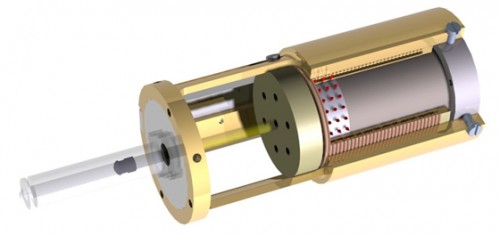 (Jet-Injection Device image courtesy of the MIT BioInstrumentation Lab)
(Jet-Injection Device image courtesy of the MIT BioInstrumentation Lab)
When I was a kid and a bona fide Star Trek junkie, I always was impressed by the clever futuristic gadgets that were mainstays of the series. One of these, the hypospray, was particularly memorable to me. Got a shipmate howling and baying at the moon due to some bizarre disease or injury? Need to do the Vulcan Neck Pinch sans Vulcan and sedate a distraught character? Well bring along Dr. McCoy with his hypospray and you are but a PFFFFFFFFFFFT! away from relief. See Mr. Sulu below? He’s about to get a can of whup-spray opened up on him.
Trivial alert: My late uncle said he used to work with George Takei in California in the banking industry, telling George how I used to get irate at my grandparents’ because they’d have dinner at the same time Star Trek reruns came on. Considering my folks had a small Motorola black and white TV and my grandparents a huge color TV, and the fact that we didn’t get Star Trek reruns out in the boonies where I lived, my fury was understandable. I bet my parents wished they had a hypospray for me. In any case, I often wondered if my uncle’s story was true…
As a kid I used to sneak up behind my sister when she was acting up, put my finger on her and imitate McCoy’s use of a hypospray to imitate the often tranquilizing effects of the hypopray in various Star Trek episodes. I sometimes still absent-mindedly do that to my youngsters.
Ho-hum, that’s a dandy bit of the personal WayBack Machine, you say. Why do I mention this, you ask? Well, scientists at MIT led by Dr. Ian Hunter have been working on a device could spell the end of wide-spread usage of hypodermic needles, operating in much the same way that the Star Trek hypospray does.
…the MIT team, led by Ian Hunter, the George N. Hatsopoulos Professor of Mechanical Engineering, has engineered a jet-injection system that delivers a range of doses to variable depths in a highly controlled manner. The design is built around a mechanism called a Lorentz-force actuator — a small, powerful magnet surrounded by a coil of wire that’s attached to a piston inside a drug ampoule. When current is applied, it interacts with the magnetic field to produce a force that pushes the piston forward, ejecting the drug at very high pressure and velocity (almost the speed of sound in air) out through the ampoule’s nozzle — an opening as wide as a mosquito’s proboscis.
The speed of the coil and the velocity imparted to the drug can be controlled by the amount of current applied; the MIT team generated pressure profiles that modulate the current. The resulting waveforms generally consist of two distinct phases: an initial high-pressure phase in which the device ejects drug at a high-enough velocity to “breach” the skin and reach the desired depth, then a lower-pressure phase where drug is delivered in a slower stream that can easily be absorbed by the surrounding tissue.
Through testing, the group found that various skin types may require different waveforms to deliver adequate volumes of drugs to the desired depth.
“If I’m breaching a baby’s skin to deliver vaccine, I won’t need as much pressure as I would need to breach my skin,” Hogan says. “We can tailor the pressure profile to be able to do that, and that’s the beauty of this device.”
Medical science as relayed to the general public tends to revolve around disease, pathogens and the pharmacopeia used to combat them, so it’s nice to laud the less-familiar biomechanical technologies that support medical science.
Fascinating stuff. Dr. McCoy may have occasional aversion pointy-eared Vulcans, but this writer has aversions to pointy trans-dermal metal objects, so any advances in this field are good news!

